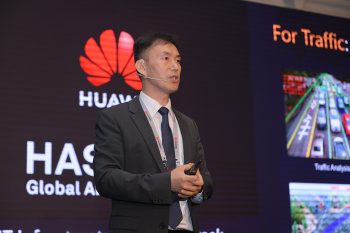
At the 15th Huawei Global Analyst Summit (HAS2018), Huawei revealed how they are utilising the “One Cloud, One Lake, One Platform” architecture to help customers innovate services and create business value for their customers in the government and public utilities, carrier, finance, transportation, and manufacturing fields.
According to Joy Huang, Vice President of Huawei’s IT Product Line, “One Cloud” refers to a converged cloud infrastructure which features unified delivery, management, and service provisioning. “One Lake” refers to a data lake. By aggregating data from all parties, a lake provides full-lifecycle data processing capabilities, including data collection, storage, computing, management, and utilization. The data lake allows enterprises to transform their data resources into data assets. Meanwhile, “One Platform” is an application enablement platform that integrates basic data services, general-purpose middleware, and industry-specific middleware to enable customers and ISVs to achieve service innovation.
Huawei has been working in the cloud, Big Data, computing, and storage domains for many years and its IT Product Line is now committed to accelerating digital and intelligent transformation for enterprises by using chips, architecture, and AI technologies. According to reports from IDC and Gartner, Huawei’s Big Data and e-Government Cloud solutions are in the leader’s position in China, and Huawei’s storage has been reaffirmed as a world leader. Huawei’s hyper-convergence infrastructure have also been seen as a challenger.
Over the years, Huawei has helped to implement digital change in a number of industries. For example, in the government and public utilities sector, Huawei has helped the Zhejiang Jiaxing government to build a data lake, which has not only simplified government work but also facilitated citizens’ daily activities. In the past, registering a new company used to take two months, and people used to visit six government departments for primary school enrollment. But now, registration process takes only five days, and the enrollment can be completed through an online application.
Creating smart cities for the future is a big part of Huawei’s mission and throughout the event, Huawei executives emphasized the fact that making cities safer, by using a combination of IoT, Big Data, AI and other technologies, is the foundation of smart cities deployments. Safe city solutions, powered by Huawei’s ICT solutions like video surveillance have been deployed in many cities. Huawei’s Safe City solution, for example, offers software-defined cameras and ultra-broadband private networks. It incorporates both distributed cloud systems and a central cloud platform, which means it can consolidate video feeds onto a single cloud to form a unified data pool. The added value of this solution is enormous: It makes safety predictable.
In addition to accumulating practical experience, Huawei has set up R&D innovation centres around the globe for IT innovation. Huawei integrates intelligent technologies into IT infrastructure and uses cloud services based on software and hardware integration to deliver superior performance and build an intelligent cloud platform. Huawei also builds data lakes to mine, aggregate, and analyse various types of data, which lays a solid foundation for Intelligent Big Data solutions.
What’s clear is that Huawei is teaming up with customers and partners to create a vibrant ecosystem in increasingly complex application scenarios – creating value for their customers, and achieving a win-win situation for continuous growth. Joy Huang mentioned that Huawei’s vision is to build a smart world where everything is interconnected. Hence, Huawei plays an active role in the open source community and promotes the standardization of cloud platforms. Huawei is the first and only platinum member and director of the OpenStack Foundation in Asia, with the contribution ranking No. 1 in China and No.2 in the world. Huawei is also ranked No. 3 and No. 4 among global vendors in terms of contribution to the Hadoop community and the Spark community, respectively.
 (0)
(0) (0)
(0)Archive
- October 2024(44)
- September 2024(94)
- August 2024(100)
- July 2024(99)
- June 2024(126)
- May 2024(155)
- April 2024(123)
- March 2024(112)
- February 2024(109)
- January 2024(95)
- December 2023(56)
- November 2023(86)
- October 2023(97)
- September 2023(89)
- August 2023(101)
- July 2023(104)
- June 2023(113)
- May 2023(103)
- April 2023(93)
- March 2023(129)
- February 2023(77)
- January 2023(91)
- December 2022(90)
- November 2022(125)
- October 2022(117)
- September 2022(137)
- August 2022(119)
- July 2022(99)
- June 2022(128)
- May 2022(112)
- April 2022(108)
- March 2022(121)
- February 2022(93)
- January 2022(110)
- December 2021(92)
- November 2021(107)
- October 2021(101)
- September 2021(81)
- August 2021(74)
- July 2021(78)
- June 2021(92)
- May 2021(67)
- April 2021(79)
- March 2021(79)
- February 2021(58)
- January 2021(55)
- December 2020(56)
- November 2020(59)
- October 2020(78)
- September 2020(72)
- August 2020(64)
- July 2020(71)
- June 2020(74)
- May 2020(50)
- April 2020(71)
- March 2020(71)
- February 2020(58)
- January 2020(62)
- December 2019(57)
- November 2019(64)
- October 2019(25)
- September 2019(24)
- August 2019(14)
- July 2019(23)
- June 2019(54)
- May 2019(82)
- April 2019(76)
- March 2019(71)
- February 2019(67)
- January 2019(75)
- December 2018(44)
- November 2018(47)
- October 2018(74)
- September 2018(54)
- August 2018(61)
- July 2018(72)
- June 2018(62)
- May 2018(62)
- April 2018(73)
- March 2018(76)
- February 2018(8)
- January 2018(7)
- December 2017(6)
- November 2017(8)
- October 2017(3)
- September 2017(4)
- August 2017(4)
- July 2017(2)
- June 2017(5)
- May 2017(6)
- April 2017(11)
- March 2017(8)
- February 2017(16)
- January 2017(10)
- December 2016(12)
- November 2016(20)
- October 2016(7)
- September 2016(102)
- August 2016(168)
- July 2016(141)
- June 2016(149)
- May 2016(117)
- April 2016(59)
- March 2016(85)
- February 2016(153)
- December 2015(150)
